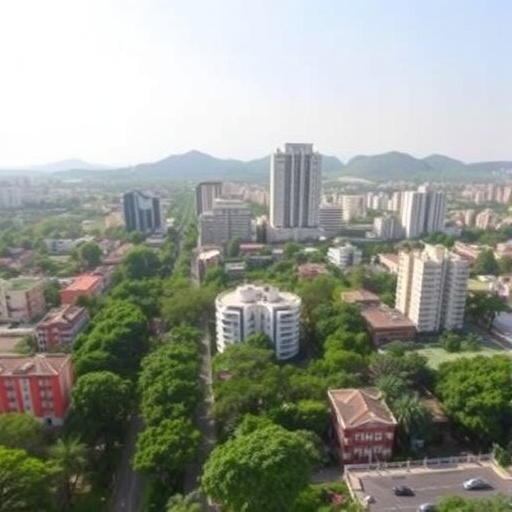In 2024, the world witnessed an unprecedented surge in dengue fever cases, marking one of the worst outbreaks in recent history. With over 14 million reported cases and more than 10,000 fatalities globally, these figures starkly surpassed the previous epidemic years of 2023 and 2019. This alarming escalation has brought renewed urgency to finding sustainable and effective interventions for dengue control, a challenge that has plagued tropical regions worldwide for decades.
Amid this global health crisis, the city of Niterói in Rio de Janeiro state, Brazil, emerged as an extraordinary example of innovation and hope. Unlike many regions struggling with soaring dengue incidences, Niterói demonstrated remarkable resilience through a groundbreaking biological intervention—the release of Aedes aegypti mosquitoes infected with the wMel strain of Wolbachia bacteria. This innovative strategy aimed to impair the mosquitoes’ capacity to transmit the dengue virus, fundamentally altering the disease dynamics in the city.
The scientific basis for this approach lies in the unique properties of the Wolbachia bacteria, a naturally occurring endosymbiont found in many insect species but not originally present in Aedes aegypti mosquitoes. When introduced into these mosquitoes, Wolbachia inhibits the replication of dengue virus within their bodies, thus preventing onward transmission to humans. Over the course of five years, systematic releases of wMel-infected mosquitoes resulted in the majority of the local mosquito population carrying the bacterium, effectively reducing the city’s dengue incidence by an extraordinary 89%.
Led by researchers from Monash University in Melbourne and the World Mosquito Program, the study assessing this intervention’s long-term efficacy was published in the journal Tropical Medicine and Infectious Diseases. The research team, including Associate Professor Katherine Anders and Professor Luciano Moreira, now CEO of Wolbito do Brasil, conducted extensive monitoring in Niterói, a city with a population roughly half a million. Their findings underscored the profound public health impact during the record-breaking dengue epidemic in Brazil in 2024.
In that year, Niterói reported a dengue incidence of just 374 cases per 100,000 population—a remarkable figure when compared to 1,884 per 100,000 in Rio de Janeiro state overall, and an even more staggering 3,157 per 100,000 across the entire country. This stark contrast evidences the intervention’s effectiveness, proving that the widespread establishment of Wolbachia within vector populations not only curtails disease transmission but also offers a scalable and sustainable solution for dengue control.
Traditional methods of controlling dengue vectors, such as insecticide application and source reduction, have encountered significant hurdles over time. Insecticide resistance has become pervasive among Aedes aegypti populations, diminishing the success of chemical control strategies. Furthermore, urban environments present complex logistical challenges for mosquito control programs, complicating efforts to maintain consistent and widespread coverage. In contrast, Wolbachia deployment circumvents these problems through a self-sustaining biological mechanism, reducing reliance on repeated chemical interventions.
The innovative method pioneered in Niterói has garnered international attention, and in July 2024, Brazil unveiled the world’s largest biofactory dedicated to breeding Wolbachia-infected mosquitoes. Located in Curitiba and named Wolbito do Brasil, this facility aims to produce millions of infected mosquitoes to supply various regions across the country. Professor Moreira highlighted that this initiative is poised to protect an estimated 140 million people from dengue fever in Brazil in coming years, marking a significant step forward in the fight against vector-borne diseases.
From a technical standpoint, the success of the wMel strain of Wolbachia in suppressing dengue transmission is attributed to several key factors. The bacterium manipulates mosquito biology by inducing cytoplasmic incompatibility, ensuring that Wolbachia-infected females produce offspring carrying the bacteria, thereby facilitating its spread through mosquito populations. Additionally, Wolbachia triggers immune system pathways within the mosquito, further limiting viral replication. Together, these mechanisms reduce the vector competence of mosquitoes without significantly impairing their survival or reproduction.
The ecological and epidemiological implications of this intervention are profound. Establishing a stable Wolbachia presence in mosquito populations can lead to a durable reduction in dengue transmission potential, decreasing outbreaks and associated morbidity and mortality over the long term. This achievement supports the hypothesis that biologically based vector control strategies can complement or even replace conventional approaches, particularly in densely populated urban centers where rapid dengue spread is common.
Despite the compelling results in Niterói, scientists emphasize the importance of continued surveillance, community engagement, and iterative optimization of Wolbachia deployment strategies. Factors such as local environmental conditions, mosquito population dynamics, and human movement patterns can influence intervention efficacy. As such, integrating these variables into ongoing monitoring will be critical for maximizing the public health benefits of Wolbachia programs as they scale to other regions facing dengue and related arboviruses.
Moreover, the success of this program resonates beyond dengue fever, offering a transferable model for controlling other mosquito-borne diseases such as Zika, chikungunya, and yellow fever. Wolbachia’s ability to inhibit multiple pathogens within the same vector underscores its potential as a versatile tool in integrated vector management frameworks. This multifunctionality equips public health authorities with a powerful strategy to confront an array of emerging threats exacerbated by climate change and urbanization.
In light of these transformative findings, the global health community is increasingly recognizing Wolbachia deployment as a paradigm shift in vector control. The compelling data from Niterói’s experience highlights the intersection of cutting-edge microbiology, vector ecology, and public health intervention science. By reducing dengue incidence nearly tenfold during a historic epidemic surge, the Wolbachia program exemplifies innovation unlocking new possibilities for disease prevention on a planetary scale.
As efforts to expand Wolbachia mosquito releases progress worldwide, ongoing collaborations between academic institutions, governmental agencies, non-governmental organizations, and affected communities will play a pivotal role in shaping the future of arboviral disease control. Harnessing this symbiotic bacterium’s power represents a lasting legacy for public health, forging a path toward safer, healthier, and more resilient tropical populations vulnerable to dengue and beyond.
Subject of Research: People
Article Title: Long-Term Durability and Public Health Impact of City-Wide wMel Wolbachia Mosquito Releases in Niterói, Brazil, During a Dengue Epidemic Surge
News Publication Date: 25-Aug-2025
Web References:
DOI: 10.3390/tropicalmed10090237
Keywords: Human health, Diseases and disorders
Tags: Aedes aegypti mosquito managementbiological intervention for denguedengue fever outbreak controlepidemic response strategiesglobal health crisis responseinnovative disease prevention techniquesmosquito-borne disease transmissionNiterói Brazil dengue strategypublic health interventions in Brazilsustainable dengue control methodstropical disease managementWolbachia-infected mosquitoes





